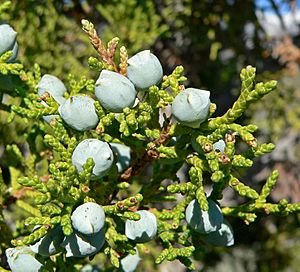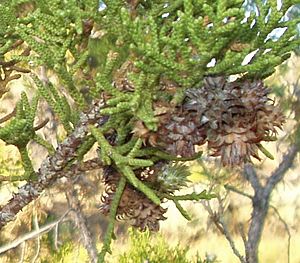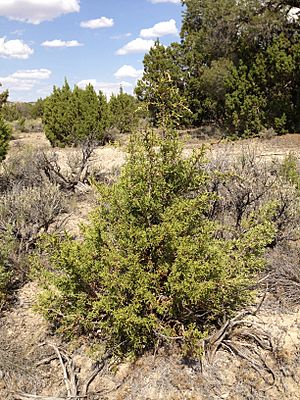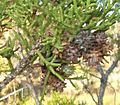Utah juniper facts for kids
Quick facts for kids Utah juniper |
|
|---|---|
 |
|
| A Utah juniper showing distinctive shape and leaves | |
| Conservation status | |
| Scientific classification | |
| Genus: |
Juniperus
|
| Species: |
osteosperma
|
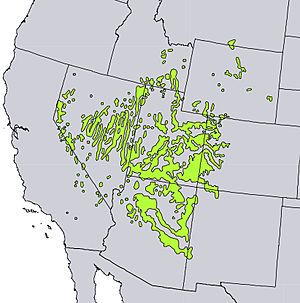 |
|
| Natural range | |
The Utah juniper (scientific name: Juniperus osteosperma) is a type of shrub or small tree. It usually grows to be about 3 to 6 meters (around 10 to 20 feet) tall, but sometimes it can reach up to 9 meters (nearly 30 feet).
This plant is found naturally in the southwestern United States. You can see it in states like Utah, Nevada, Arizona, and parts of New Mexico, Colorado, Wyoming, Montana, Idaho, and California. It likes to grow in dry places, often at medium heights, from about 1,300 to 2,600 meters (about 4,300 to 8,500 feet) above sea level. It often grows alongside another tree called the Single-leaf pinyon.
Contents
What Does the Utah Juniper Look Like?
The branches of the Utah juniper are quite thick, about 1.5 to 2 millimeters wide. Its leaves are small and scale-like, usually 1 to 2 millimeters long. On new growth, they can be up to 5 millimeters long. Young plants have needle-like leaves that are longer, about 5 to 10 millimeters.
Cones and Seeds
The Utah juniper has special berry-like cones. These cones are about 8 to 13 millimeters wide and are blue-brown with a waxy white coating. Each cone usually holds one seed, but sometimes two. It takes about 18 months for the cones to fully grow. Birds and small animals often eat these cones, which helps spread the seeds.
The male cones, which produce pollen, are smaller, about 2 to 4 millimeters long. They release their pollen in early spring. Most Utah juniper plants have both male and female cones on the same plant. However, about 10% of these plants only have cones of one sex.
What Are Juniper Galls?
You might notice strange bumps on Utah juniper plants. These are called galls. They are caused by a tiny insect called the Juniper Tip Midge. These galls look like pale violet-purple clusters, with 5 to 20 galls growing together. Each gall is about 1 to 2 centimeters wide and has dense, modified leaves.
How Utah Juniper Seeds Spread
Many different animals help spread the seeds of the Utah juniper. Mammals like jackrabbits (especially the Black-tailed jackrabbit) and rodents eat the berries. Coyotes also help, but less often. Among birds, the Townsend's solitaire is well-known for eating juniper berries and spreading their seeds.
Uses of the Utah Juniper
Native American tribes have used the Utah juniper for many purposes.
Traditional Uses by Native Americans
- The Havasupai people used the bark of the Utah juniper for things like making beds. They also ate the cones, both fresh and baked into cakes.
- The Havasupai also used the sticky gum from the tree to cover and protect wounds.
- The Yavapai tribe made a tea from the leaves to help women after giving birth. They also used smoke from the leaves on hot coals to fumigate.
- The Navajo people would sweep their tracks with juniper branches. This was done to prevent bad luck or death from following them.
Other Uses
- A small amount of ripe juniper berries can be eaten if needed for survival, or used as a seasoning for meat, similar to sage.
- Dried juniper berries can be roasted and ground up to make a coffee substitute.
- The Utah juniper is an aromatic plant. Its essential oil, taken from the trunk and branches, has a strong smell from chemicals like alpha-pinene and delta-3-carene. The oil from the leaves smells like camphor.
Images for kids
-
Utah Juniper galls
See also
 In Spanish: Juniperus osteosperma para niños
In Spanish: Juniperus osteosperma para niños



